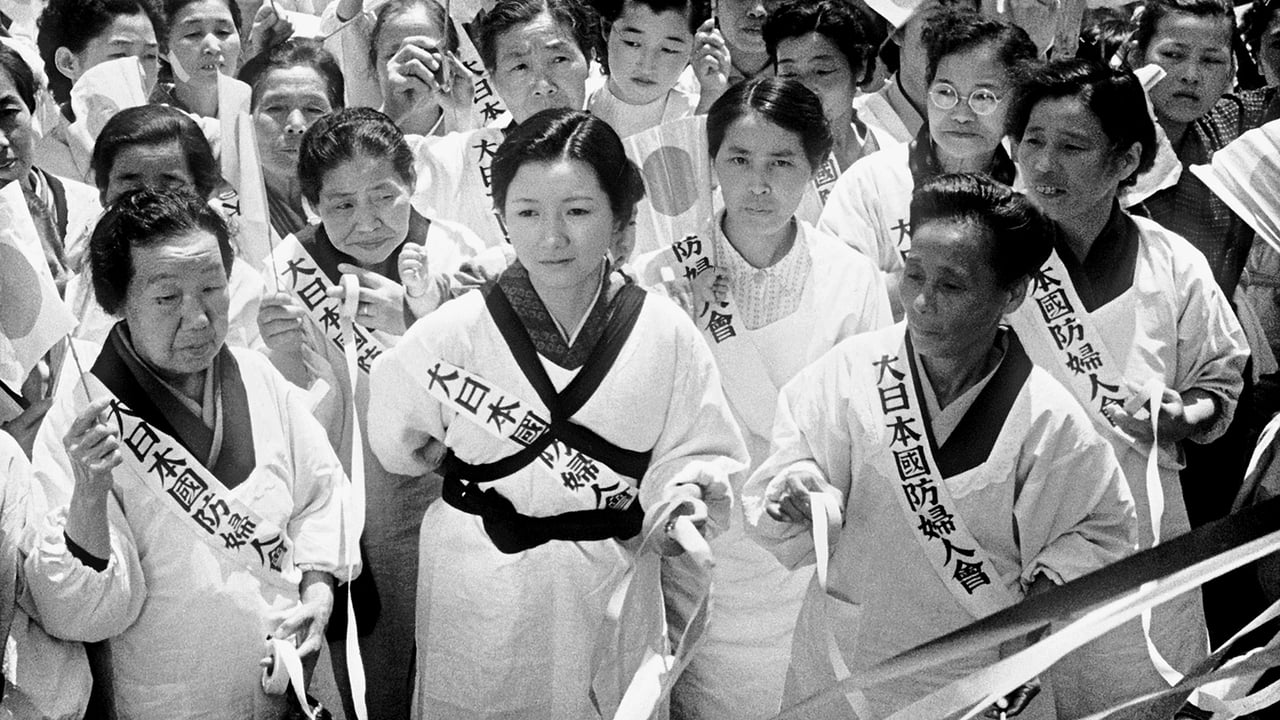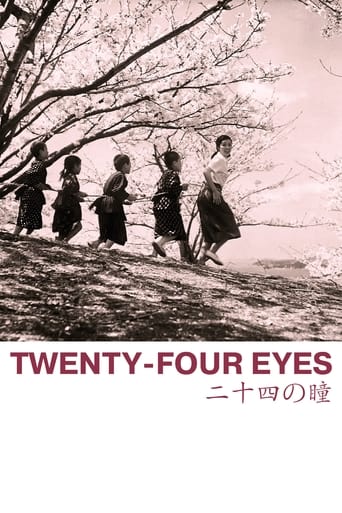

Viewed on DVD. Editing = 2.5 stars; restoration = 2.5 stars. Director Keisuke Kinoshita's lyrical outing suffers from an attempt to blend epoch drama with an all-purpose (Swiss-army-knife) children's choral concert. The mash up is quite effective when the Director sticks with cute first-grade school songs. Not so much when his children's chorus sings lyrics that: consist of blank-verse nonsense (a phenomenon often found on the sound track of films from this era); take on an unrealistic adult perspective; provide expository information (voice-over singing); deliver travel logs; provide third-party points of view; etc. In short, this incessant "racket" rapidly becomes an irritant especially when it keeps interrupting the very engaging story line. The film needs a good scrub by an experienced musical director (which would also shorten a too long film and keep the focus squarely on the unfolding high drama). It is amusing to see that school classes seem to be limited to--you guessed it--singing! No less interesting is the lack of continuity when 12 first-grade children (24 eyes) suddenly become 20 or more (40 eyes!). Kinoshita makes effective use of very long scenes by ensuring they remain engaging. Acting, however, is uneven due to limitations in script and direction. The talents of leading actress Hideko Takamine (playing a "modern" school teacher) are squandered with dialog along the lines of "I don't know what to say" and "I can't say anything now" and ever present sobbing (more than half of Takamine's performance is limited to crying!). Distinguished actor Chishû Ryû is both miscast and misdirected playing a clueless first-grade music teacher. Director Kinoshita also over doses on cute (but hammy and obviously staged) mug shots of children (the same shots are repeatedly shown). Subtitles do not translate hand writing and some singing bouts. Cinematography (narrow screen, black and white) uses an antique format (perhaps due to budging issues and/or fear of updating?). Editing errors and restoration that does not correct for same occur with each inter-scene dissolve in the first third of the movie. Linked scenes go out of focus just before and immediately after each dissolve (could at least be replaced with jump cuts during restoration?). Sound dubbing is OK. Nonchoral music consists of a rich score that include some riffs on Steven Foster and Auld Lang Syne. Enjoyable, especially if you are into choral music big time! WILLIAM FLANIGAN, PhD.
... View MoreKeisuke Kinoshita is perhaps among the least known, here in the West, of all the great Japanese directors and his films are not often seen here. His 1954 film "Twenty-Four Eyes" is one of his very best pictures yet it is hardly known at all now despite having won the Golden Globe for Best Foreign Film, (it's sentimental story of an inspirational teacher is just the sort of thing that would appeal to an American audience though this masterpiece is altogether deeper). What distinguishes it from, say, a similar American film is not only Kinoshita's superb narrative but a wonderful feeling for landscape, (it's set on one of Japan's largest islands), as well as the beautifully naturalistic performances of all of the children. At over two and a half hours it never outstays its welcome despite most of its major dramas happening off screen. It's also one of the most subtle of all post-war Japanese films to touch on political issues as well as the War itself, (it begins in 1928 and covers a period of 18 years). It is also a film of considerable charm and is, finally, incredibly moving. This is a real discovery that should rightly restore Kinoshita to the very front rank of world class directors.
... View MoreOne should be very careful when one uses superlatives, but, 'Twenty-Four Eyes' is one of the best movies ever made. Moreover, it is more than ever highly topical, albeit shot in black and white. It is the story of the emotional link between a junior teacher and her class of 12 children.Keisuke Kinoshita's movie tackles directly such crucial issues as freedom of speech (if you speak out against the war, you could lose your job), as calling a spade a spade (a war means simply killing people), as the choice between war and peace, between love and hate, between care (for the children) and selfishness and between sincerity and deceit or worse denouncement. His movie makes one understand that there is an all powerful authority which intervenes behind the scene in people's lives, by manipulating public opinion and by trying to turn the population (and mostly its children and young men) into deaf-mute pawns in order to use them as cannon fodder. Another means is starving the dissidents by firing them. Keisuke Kinoshita's characters are anchored in real life with its poverty (nothing to eat, or no money to go to school), its illnesses (tuberculosis), its accidents and, most importantly, the war and its victims.Keisuke Kinoshita knows what true art is. It is not an expression of emotions, but the creation of emotions (involvement) into the spectator's heart. His movie stands in sharp contrast with the actual avalanche of movie products pieced together with Meccano aliens (concocted with special effects) fighting human killers, while both are shouting their immoral gospel of violence and death. A truly cold world, and in no way the warm atmosphere created by Keisuke Kinoshita's school teacher. 'Twenty-Four Eyes' was shot by a director with a big heart, who made simply an everlasting sublime movie. A must see.
... View MoreMostly unknown and frequently dismissed in the West, this film is often considered by the Japanese to be one of their very best films, if not their best. I concur with the Japanese. I can understand the issues people have with it, namely that it is overly sentimental, but I think it mostly earns the tears that are shed over it. It's a film in the classic teacher genre, like Goodbye Mr. Chips. Hideko Takamine plays Hisako Oishi, a young woman who begins the movie as a first grade teacher on a small island in 1928. Being a small population, she ends up staying with the same students for several years. The film ends in the 1950s, so you kind of know what will probably happen to her male students, and what she and her female students will have to experience. It may be somewhat predictable, but it's incredibly heartbreaking. The film is beautifully made, and filled with Japanese folk songs (strangely, the score of the film is made up of a bunch of Western music, including "Bonnie Annie Laurie" and "There's No Place Like Home"; it's definitely a flaw). Takamine, who starred in several Mikio Naruse films around the same time, is exceptional.
... View More